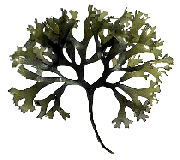
Latin name - Chondrus crispus
aka -
Carrageen,
Carrageenan,
Carragheen
Family - Gigartinaceae / Rhodophyta
Parts used - Plant, dried.
Purported actions -
anti-coagulant, anti-inflammatory, demulcent,
emollient,
expectorant, mucilaginous, tonic
Methods of use - medicinal
Constituents -
mucilage,
polysaccharides (
carrageenans), sulphur compounds,
protein, iodine, bromine, iron, other mineral salts, vitamins A and B1.
Origins - Irish Moss is an edible seaweed that grows among submerged rocks off the coasts of Britanny and Ireland.
Description - Irish Moss is not a moss it is a seaweed. It has curly fronds and varies in colour from a greenish-yellow to a dark purple or purplish-brown; but when preserved it turns a yellowish and translucent.
Attributed medicinal qualities - Irish Moss is traditionally given as a nourishing food for invalids and is still used to boost the body when recovering from a serious illness, due to its high content of important nutrients (it said to contain 15 of the 18 elements composing the human body).
It has also been used to treat bronchitis, goiter, thyroid problems, and to tone and strengthen the body's glands. People have also used it as a laxative and a home remedy for sore throats and chapped skin.
Other healing properties of Irish Moss include mild anticoagulant effect on the blood; treats chronic lung diseases, dysentery, diarrhea and disorders of kidney and bladder. Experimental results have shown that Irish Moss may also reduce high blood pressure. The large quantity of mucilage also makes it a valuable remedy for the treatment of digestive conditions where a demulcent is required, such as gastritis and in various forms, it is said to relieve peptic and duodenal ulcers in without having any adverse effects on the colon. It is also perported to reduce gastric secretions and has been used in absorbent surgical dressings.
History - "Carraigeen" is gaelic for "moss of the rock. Irish Moss was most famously used by the Irish during the famine of the 19th century. In the past it has been used as a mattress stuffing, as cattle feed, and as a thickener for colored inks used in printing.
According to ancient Irish folklore, it was carried on trips for protection and safety and was used widely in the treatment of tuberculosis and pneumonia.
Cultivation - It is not possible to cultivate this plant.
Harvesting, preparation and storage - Chondrus may be collected from the rocky coasts of north-west Europe at low tide all year round, however polluted areas should be avoided.
It requires thorough rinsing before use. It needs to be soaked and then well cooked with the liquid to be set and does not dissolve completely
The dried herb is best made into a decoction. Steeping half an ounce of the dried herb in cold water for 15 minutes and then boiling it for 10-15 minutes in 3 pints of water (or milk). It is then strained and often combined with liquorice, lemon, ginger or cinnamon. It may be sweetened to taste.
Culinary Uses - Irish moss may be used as an alternative to gelatine, acting as a natural gelling agent in soups, stews, gravies and salad dressings.
Add one cup of Irish Moss to three cups of milk or water and flavour (with cinammon and sugar) to taste. Simmer slowly until most of the seaweed has dissolved. Remove any undissolved fragments and pour into a mould to set.
Magical Uses - Irish moss can be carried or placed beneath rugs to increase luck and to ensure a steady flow of money into the house or pockets of the person.
Irish moss can also be carried while on trips for protection and safety, or used to stuff luck or money sachets.
- used as a stabilizer in such dairy products as ice creams, sherbets, chocolate milk, yogurt and whipped cream
- used in lotions to soften the skin & prevent premature wrinkling
- used to thicken cosmetics
- used as a binding agent in toothpastes etc.
- used in brewing as a fining